Sevilla and AS Roma face each other in Budapest in the UEFA Europa League final tomorrow in a game that could save both clubs’ seasons. On the one hand, we have the record holder Sevilla seeking their seventh Europa League trophy and on the other, Roma is looking for their first Europa League trophy and to win a European trophy for the second consecutive year.
Although Sevilla is the most prestigious team in this competition, Roma have a manager who never lost a European final and who is pursuing his sixth European title: José Mourinho. If we had to describe Roma’s team in one word, we would define them as pragmatic or objective while Sevilla are a team that like to hurt the opposition by having possession most of the time.
It will be exciting and very interesting, from a tactical perspective, to see this clash and to do a post-game analysis between two different philosophies from two different countries.
In this tactical analysis, we’ll try to unveil both of the teams’ tactics and lineups and, besides that, look at their strengths and weaknesses.
Potential lineups
Firstly, as a goalkeeper, the Moroccan Yassine Bounou is the main candidate.
Yet, for the left-back position, Sevilla has a massive setback for this final. Marcos Acuña won’t play because he was suspended in their last European game against Juventus. The 30-year-old Brazilian Alex Telles is the most likely candidate to occupy this left-back position.
Even though Nemanja Gudelj and Loic Badé will probably play as centre-backs, we have some apprehension regarding the Frenchman who compromised his team in the goal suffered in such a decisive game against Juventus. With that said, the manager José Luis Mendilibar could opt for a more experienced player like the Dutch Karim Rekik.
Due to his high experience and quality, Jésus Navas is the most probable player to perform as a right-back. In the midfield, they are expected to play Fernando, Ivan Rakitić slightly ahead, and Oliver Torres as the offensive midfielder.
The left winger will could be played as usual by the technician Bryan Gil, while the right wing position is way more competitive. In fact, there are three main candidates: Lucas Ocampos, Suso and Erik Lamela. However, we think that Lucas will be in the initial XI due to both his physical and defensive commitment. Finally, it is more than likely that, the goalscorer of Sevilla, Youssef En-Nesyri, will be the first choice as a striker.
Sevilla (4-2-3-1): Bounou; Telles; Gudelj; Badé; Navas; Fernando; Rakitić; Óliver; Gil; Ocampos; En-Nesyri
On the other hand, similar to other Italian teams like Inter or Juventus, the Giallorossi are expected to play with three centre-backs in a 3-4-1-2 system. The experienced Portuguese Rui Patrício will be in goal and the back three will, in all likelihood, be played by the most capped centre-backs: Gianluca Mancini, Chris Smalling and Roger Ibañez.
The decision concerning the fullbacks is conditioned by José Mourinho’s game approach, in other words, we expect a prudent and conservative Roma, and as it goes, we also expect fullbacks that can give their team a larger defensive consistency. With that said, we foresee Zeki Çelik as a right-back and Leonardo Spinazzola as a left-back, setting aside more offensive options like Nicola Zalewski and El Shaarawy.
Due to the importance of this game, we anticipate a physical and experienced midfield with Nemanja Matić and Bryan Cristante lower on the pitch. Ahead of these two, the captain Lorenzo Pellegrini is the most likely option to perform as an offensive midfielder.
On the front, Tammy Abraham will, in all likelihood, play as the most advanced element of Roma’s team. As a Tammy attack supporter, we also have several options with Paulo Dybala being the one with a higher chance of playing, due to his offensive quality. However, his physical conditions can influence José’s choice, with Andrea Belotti or even El Shaarawy as alternatives.
Roma (3-4-1-2): Patrício; Çelik; Mancini; Smalling; Ibañez; Spinazzola; Cristante; Matić; Pellegrini; Dybala; Abraham
How and where Sevilla can hurt the Italians?
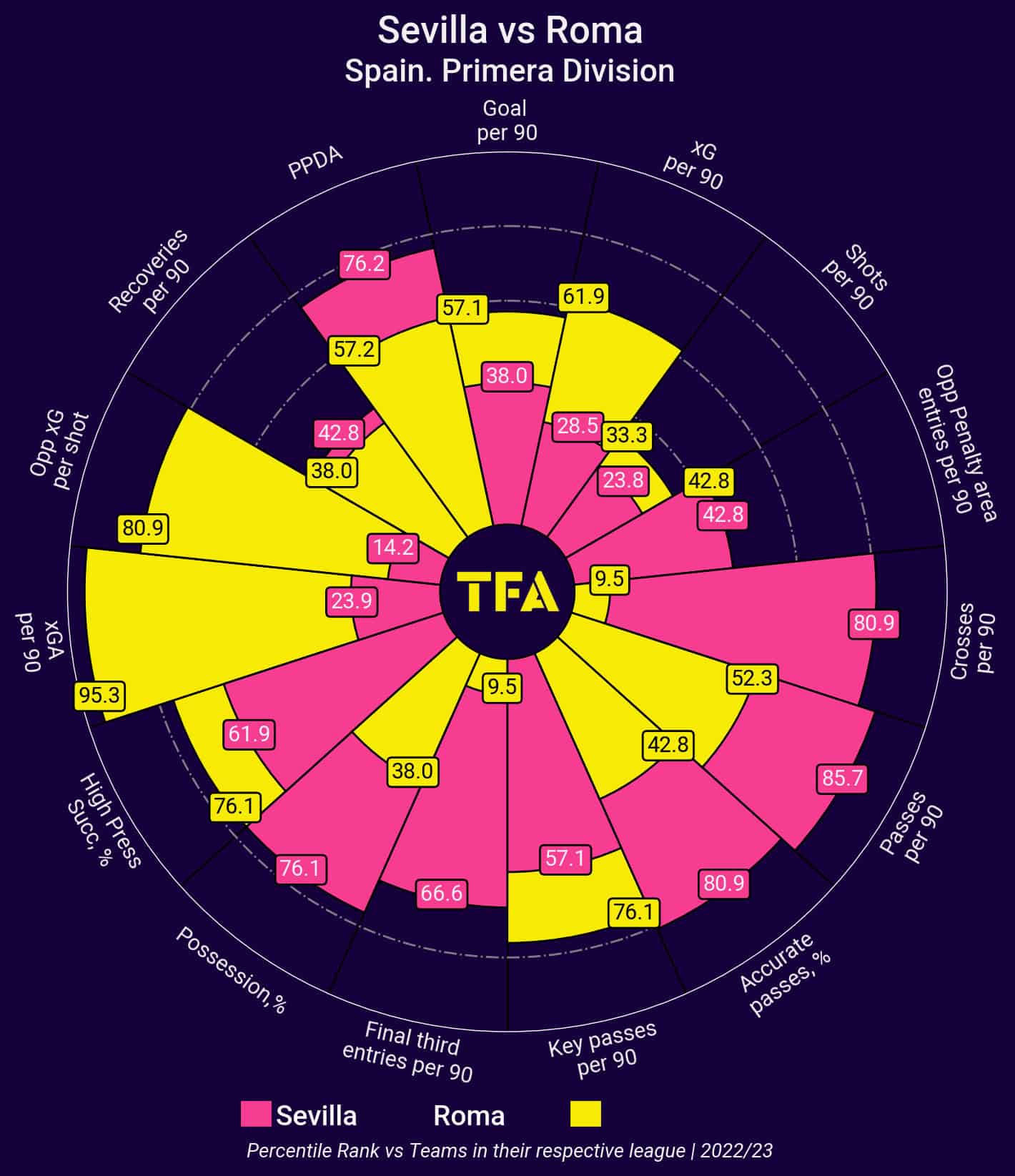
As demonstrated by the above image, Sevilla are a team that like to hurt the opposition by having the ball most of the time (ranked in the 76.1 percentile %), contrarily to Roma who, as a whole, during a large part of the game is out of possession (ranked in the 38 percentile %).
We can preview a game where, for the majority, Sevilla will have more ball and that will be moments where the Spanish team will overload Roma’s defensive line forcing them to descend their lines. This strategy increases Sevilla’s chances to score in the final. However, they’ll face a team that is used to defending with lower lines for long periods of time, and as it goes, it will not be easy.
They will try to penetrate into Roma’s box via short passes or, most commonly, via crosses especially by the left side which Alex Telles is a specialist in. It will be interesting to watch the duels inside Roma’s box between their centre-backs and En-Nesyri. In fact, it is expected that Roma’s defenders give special attention to the Moroccan due to his aerial and physical capacity but the wingers should be aware of the space that is created with his movements inside the box. It is important to say that details like this can decide a final.
For example, in this image, we can see that En-Nesyri attracted two defenders and the winger was left alone to attack the free space.
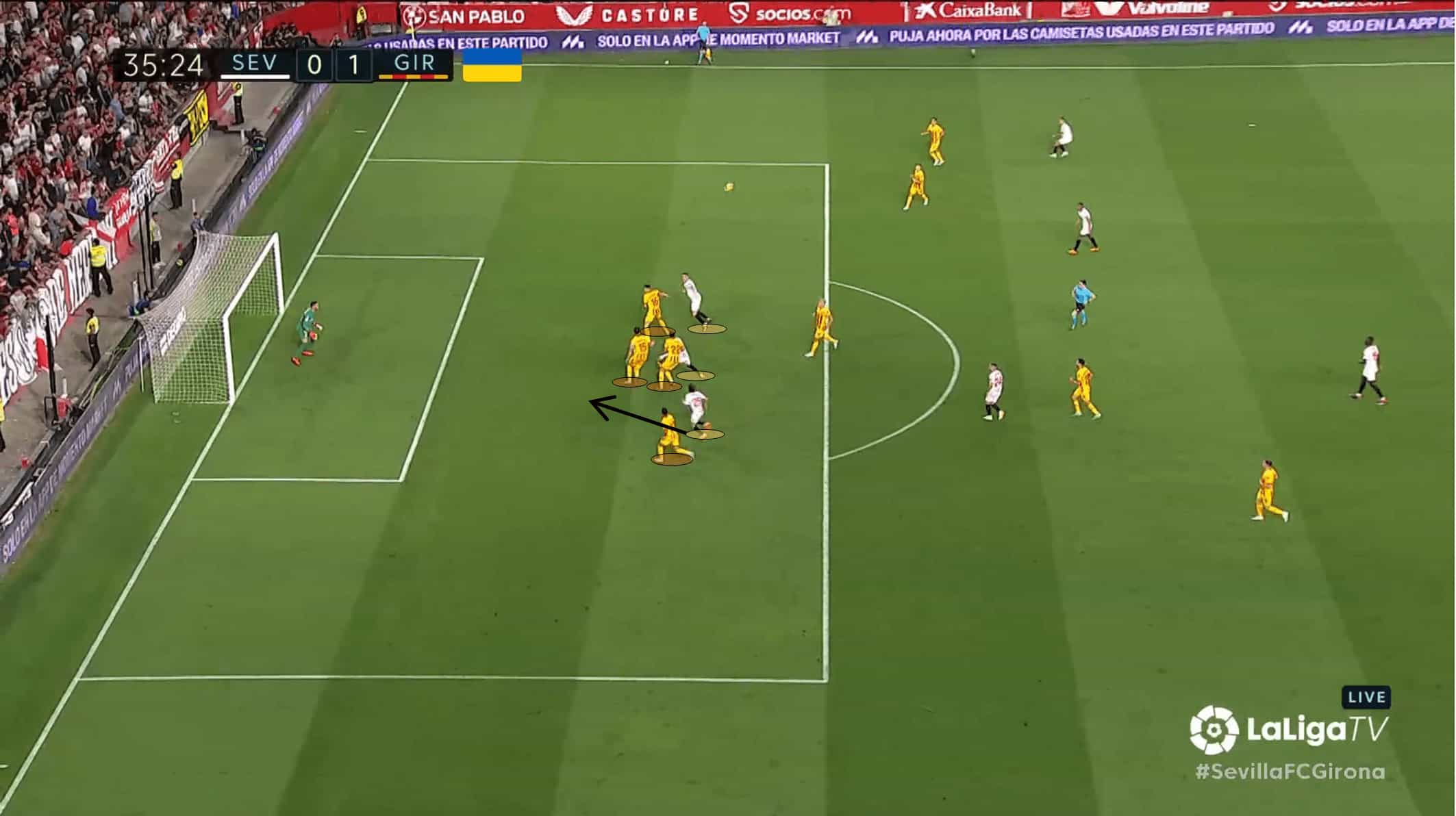
As we previously mentioned, we expect Roma’s fullbacks to be cautious during the offensive process, however, if they neglect their defensive duties, Sevilla are a team that has real capacities to harm the Italian collective with a counterattack. For instance, they rank in the 85.7 percentile in passes per 90 minutes and in the 80.9 percentile (%) in accurate passes.
In the image below we can observe a situation where Roma’s fullbacks were too projected and this situation led to a promising and dangerous counterattack.
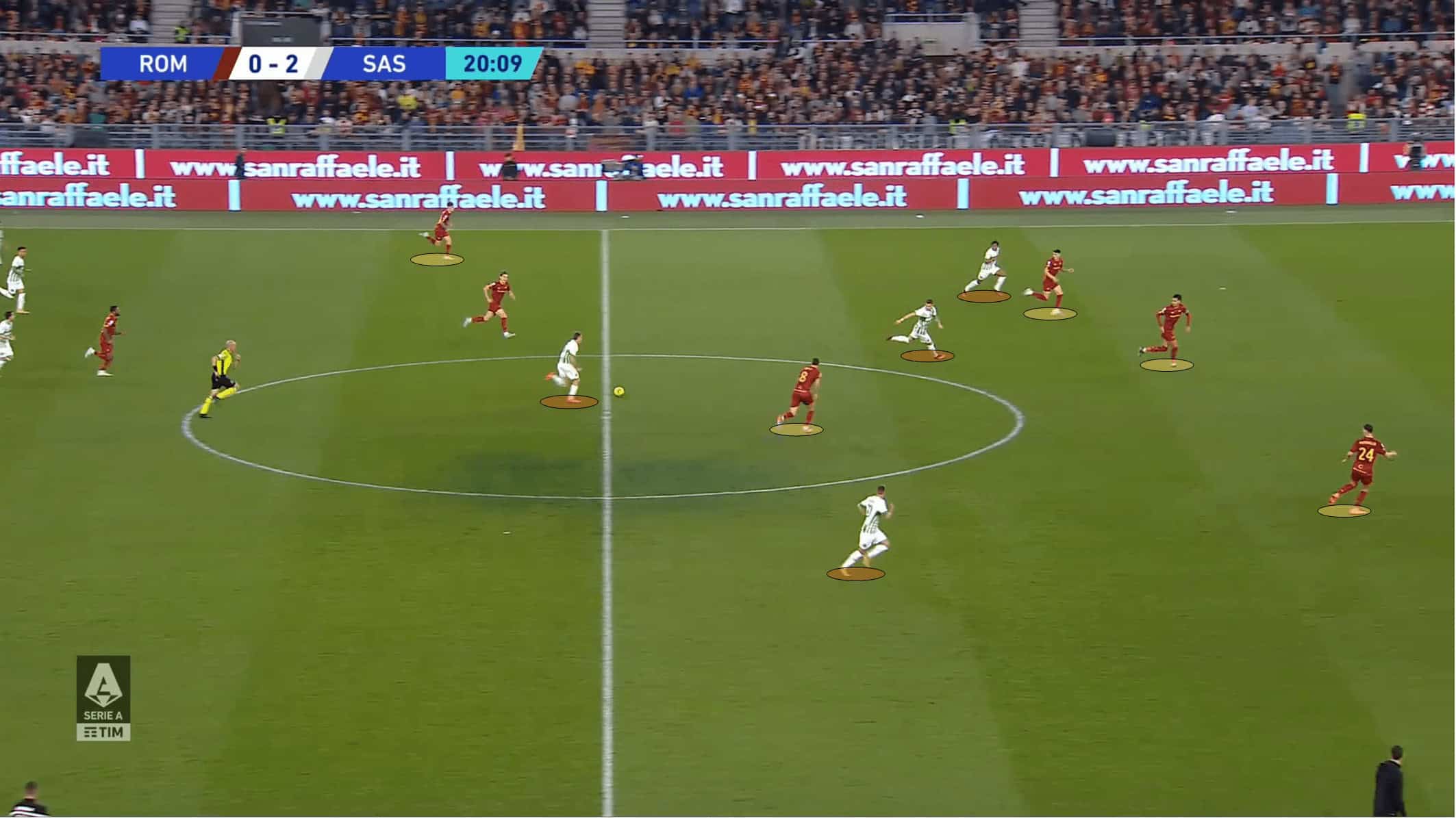
Roma’s menaces against some of Sevilla’s defensive flaws
Although they are reversing this trend, Sevilla suffered 73 goals this season in all competitions, this massive stat can be explained by some defensive details as we are going to explain further.
In our view and contrarily to a significant part of the public opinion, Roma’s football isn’t defined by constant direct football and lacks offensive complexity. In fact, as we will to specify, José created a hybrid possession plan where the team feels comfortable in building up from the back and playing more direct football, seeking Tammy most of the times.
Actually, there are teams that focus themselves on a short passing build-up plan, and when it isn’t working, this leaves them without alternatives and their possession becomes highly compromised. On the other hand, for example, when Roma’s build-up is being obstructed, the direct game becomes an option and, from there, they are capable of maintaining the possession.
However, these through balls have some tactical know-how behind them, especially in what concerns the mobility of the front two plus the offensive midfielder.
Let’s be more concrete on this subject. One of the most common offensive and off-ball movements for Roma is, when the ball carrier (normally the fullback) is being pressed, Tammy descends to support him. Instantly the offensive midfielder and the remaining striker seek the depth in the space created by that movement.
In the image below, we can observe a perfect example of this action where Zalewski with his first touch makes a long pass in depth. Both Wijnaldum and El-Shaarawy were seeking that space, while Tammy stood behind due to his movement.
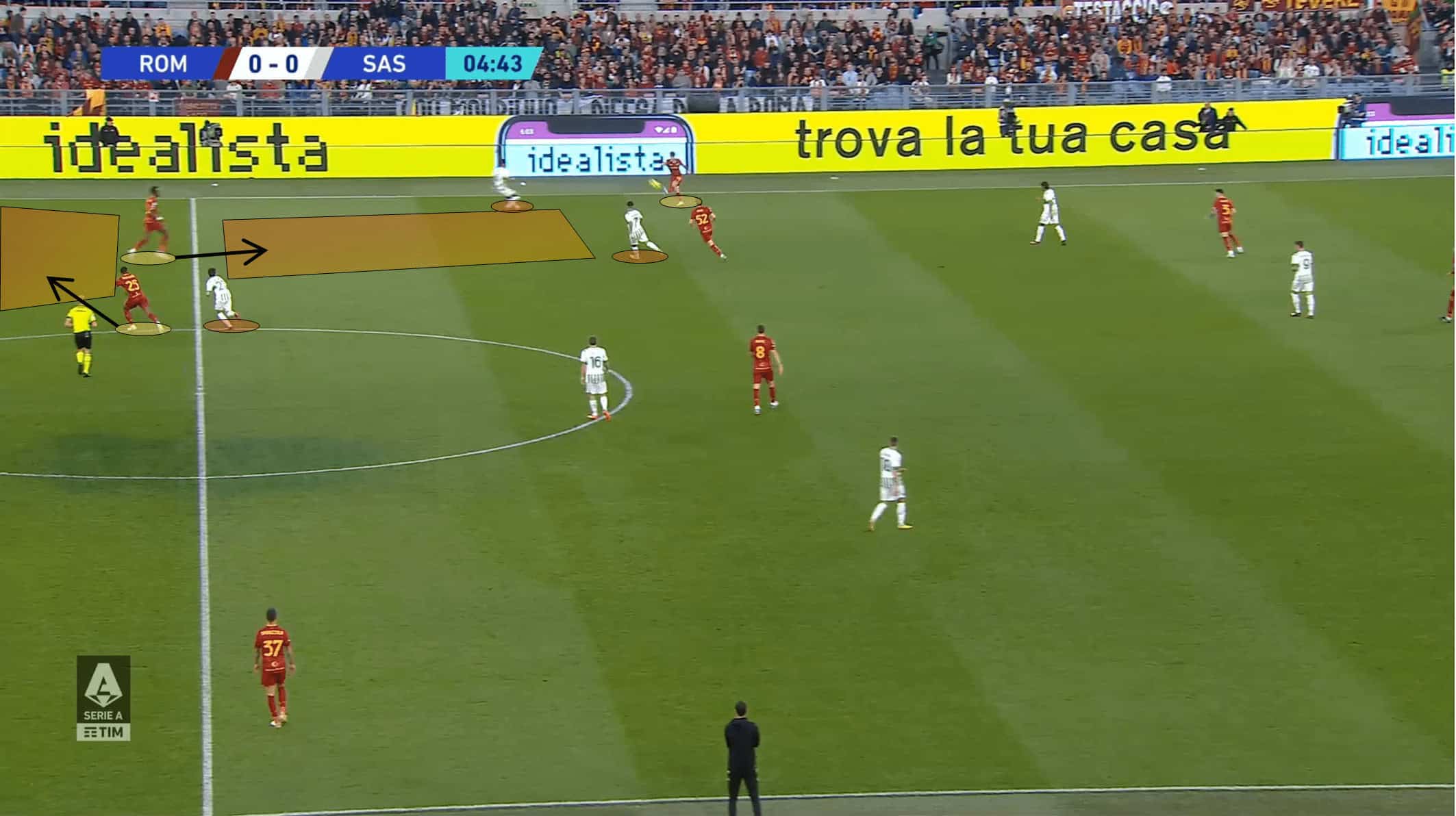
If instead both Tammy and the other striker choose to explore the depth, then a huge space is created between the lines. Such space is usually occupied by the offensive midfielder who, in that position, has the freedom and time to create dangerous situations like key passes or even shots from distance.
We can see Paulo Dybala exploring that space right behind Fernando and Rakitić’s backs and using his powerful shot or even his creativity to make a key pass.
The image below describes this exact situation. However, Wijnaldum (played as an offensive midfielder in this game) is attracted by the ball carrier and leaves a huge space with no occupation.
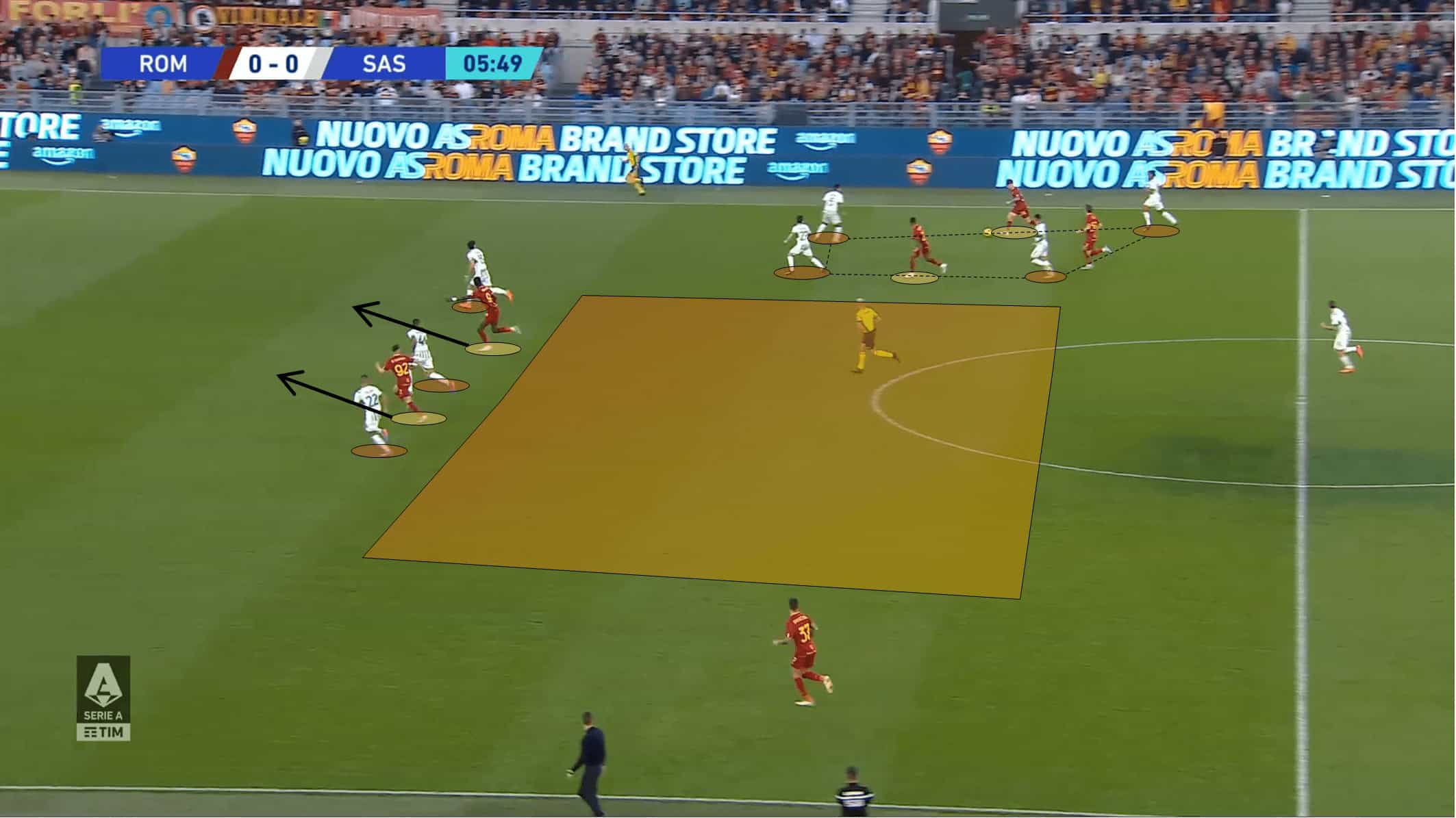
Another factor that contributes positively to Roma’s offensive success is the number of players that are attacking inside the box during a crossing situation. Besides that, the zones that they are attacking have equal or even more importance than the number of players inside the box.
In normal terms, Roma attacks the box with five players where one of the strikers attacks the near post, the other striker plus the offensive midfielder attacks the middle of the goal, the opposite fullback attacks the far post and finally, one midfielder attacks the penalty spot.
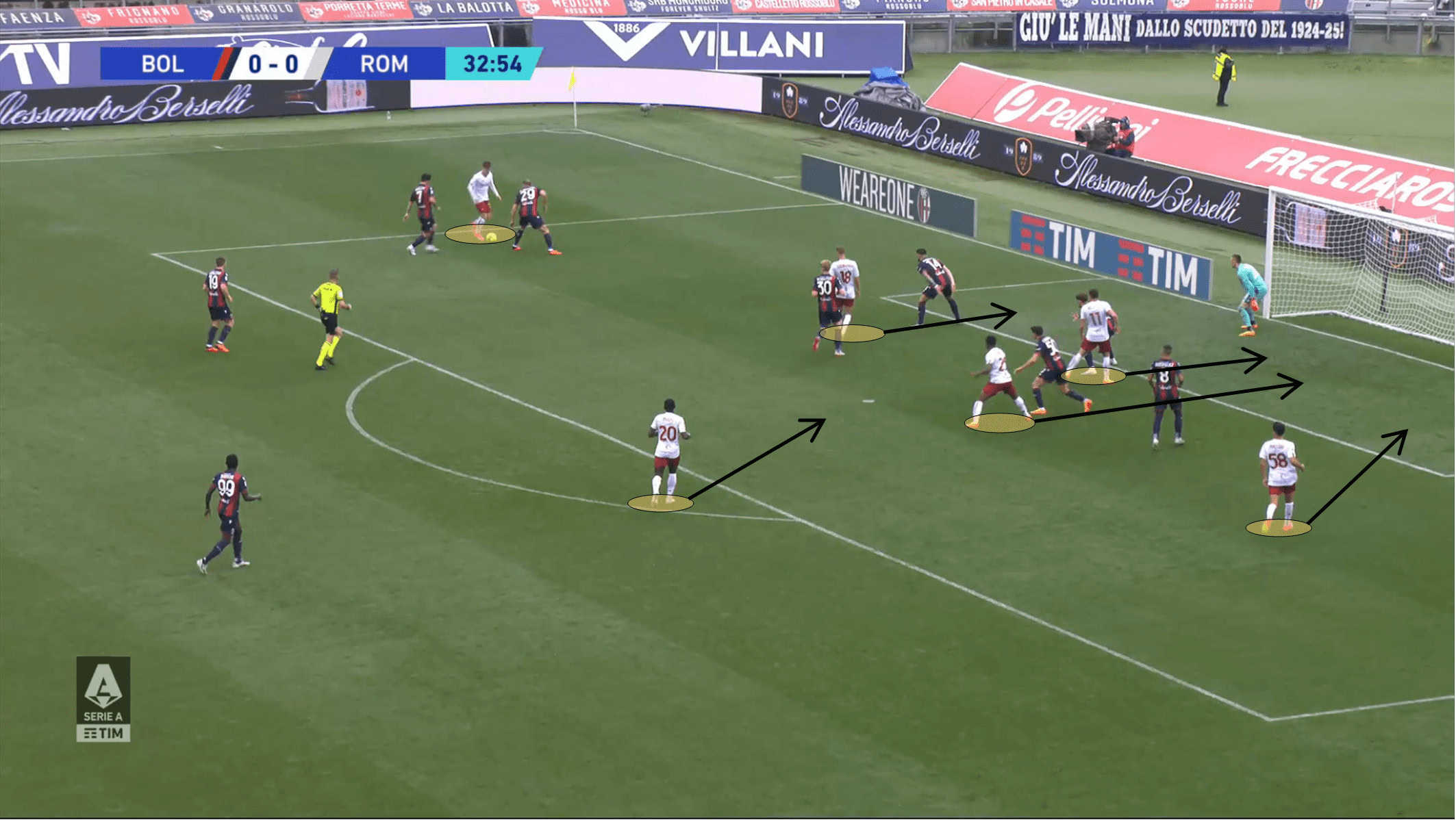
However, it is important to refer that the opposite fullback’s involvement is directly related to Roma’s strategic plan for that specific game. For instance, against Sevilla, we expect that the opposite fullback rarely enters the opposition box during crossing situations, in order to ensure Roma’s defensive process, especially defensive transitions.
Most importantly, in the way we see it, the Giallorossi can benefit from these crossing situations due to Sevilla’s insufficient defensive performance in these types of scenarios. To be more accurate, Sevilla’s defensive midfielders occasionally leave the penalty spot open and when they play against such a team, like Roma, who is harmful in these types of situations, then the final result can be compromised by these small details.
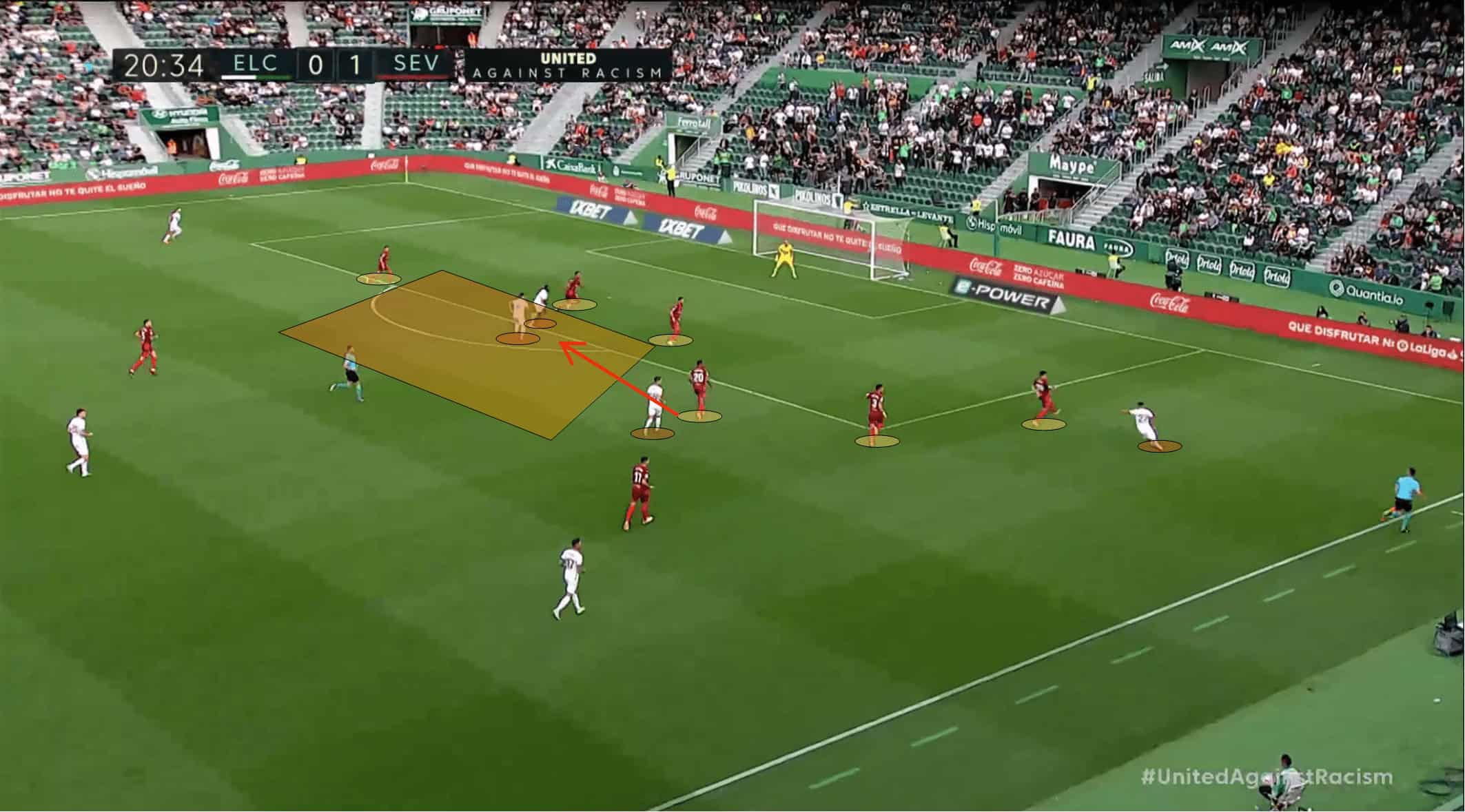
Yet, when there’s missing a player in that zone, Gudelj and the left back seemed to have a good tactical understanding and often cover of their zones. In the images below, we can see Gudelj using his former defensive midfielder skills to scan the penalty spot area when the cross is being taken and then tackling his opponent.
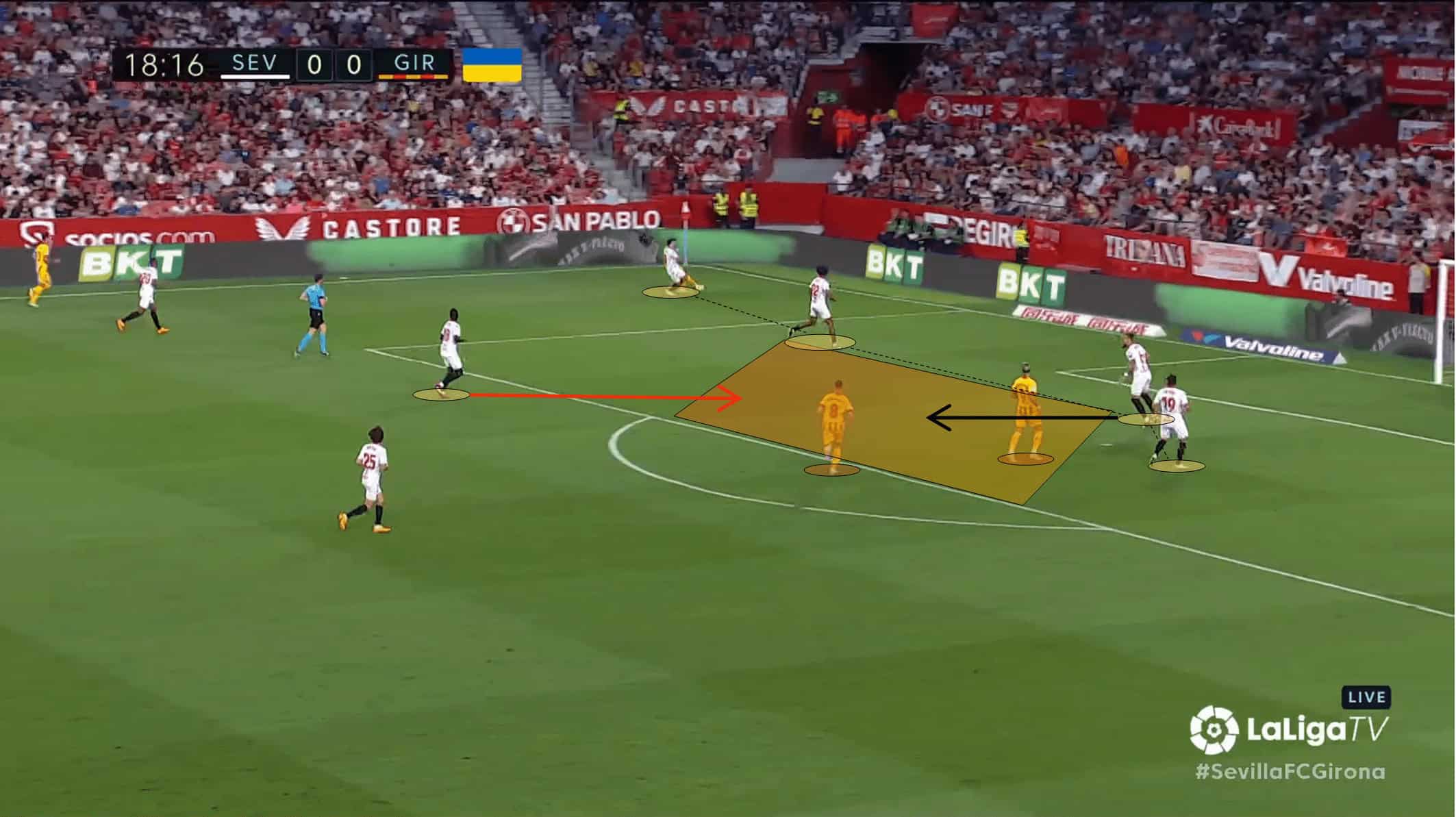
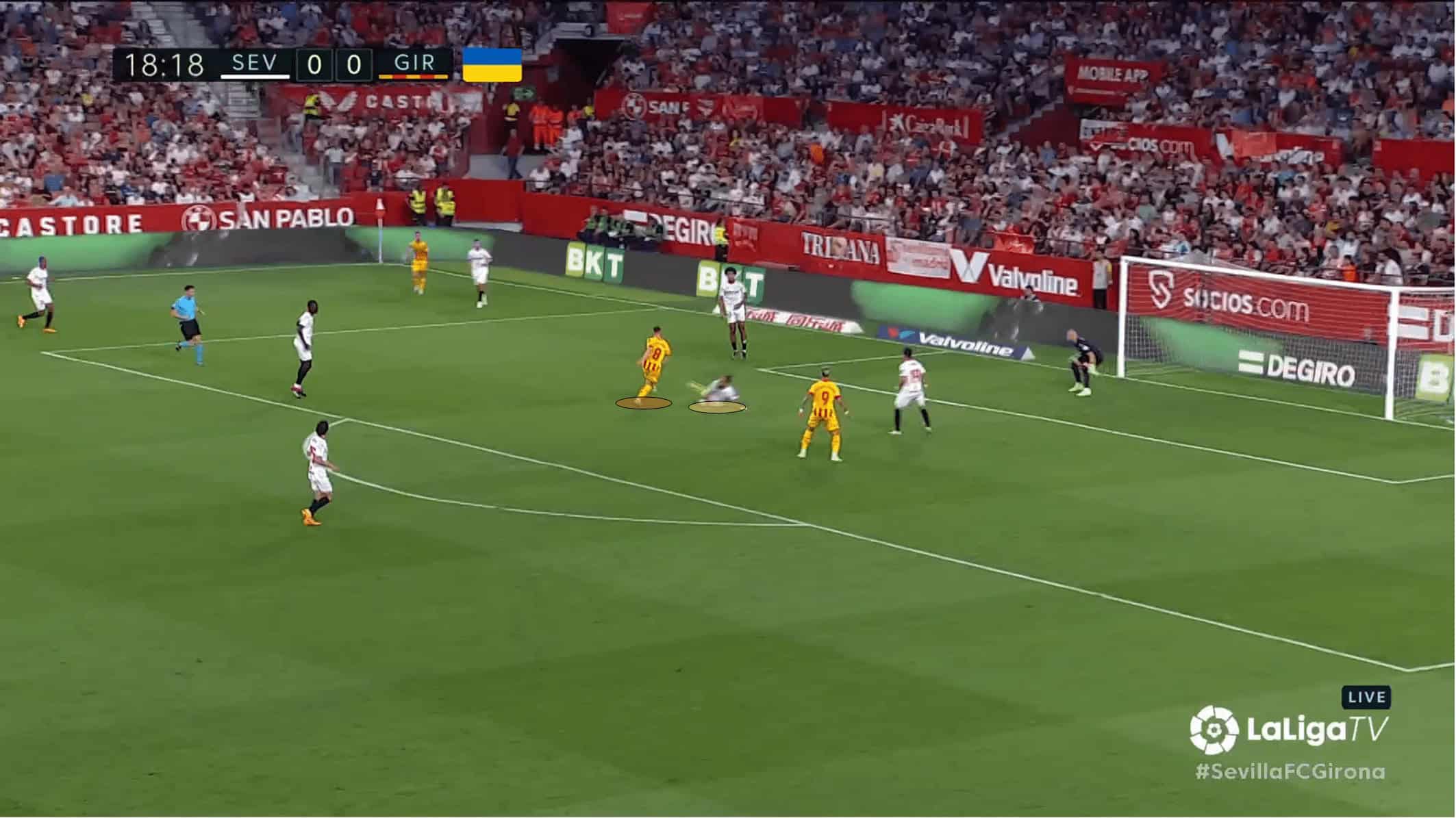
In the next image, we can see Marcos Acuña (left-back) dividing between his normal and a more interior positioning to compensate for the defensive midfielder’s flaw.
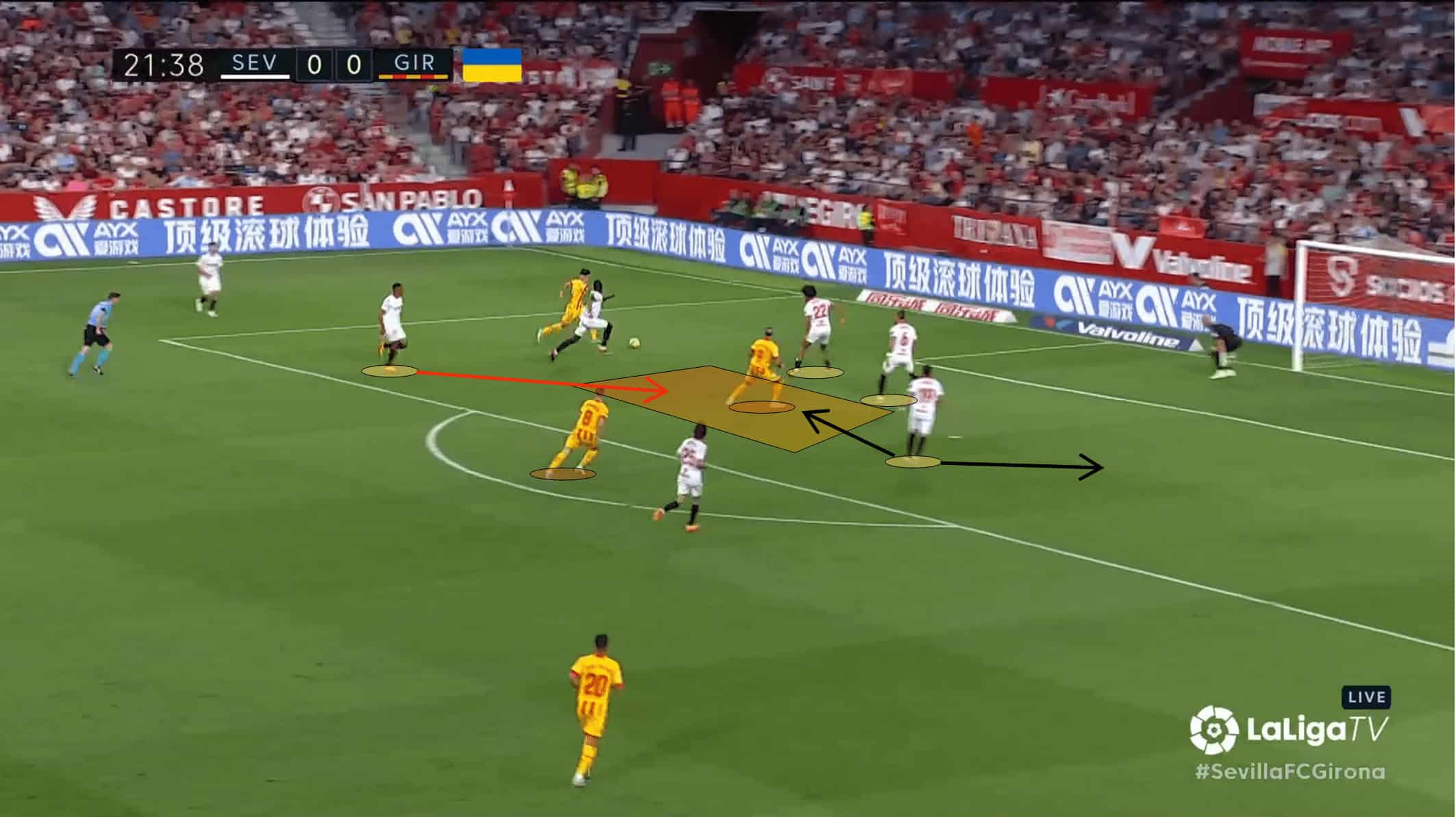
Finally, Roma is also very dangerous in set pieces, especially when Smalling and Ibañez are present in the box. Besides that, Tammy Abraham, Cristante, Mancini and Matić are also capable, in physical terms, to hurt Sevilla in set pieces.
Conclusion
This will be a very intense and well-disputed match between two sides with different approaches to the game, with Sevilla more comfortable in possession and Roma very aware of their attackers’ movements and their defensive process.
At this stage, teams are very well prepared in technical, tactical, physical and mental terms, and these big games are most of the times decided by small details. Experience will play an important role both on and off the pitch and the fact that Mourinho and Mendilibar are almost the same age will contribute to an even more balanced match.
We preview a final where initially both of the teams will be prudent in the offensive process and very aware defensively. However, sooner or later, the game will open up and both of the teams will expose themselves by increasing their offensive intensity.






Comments